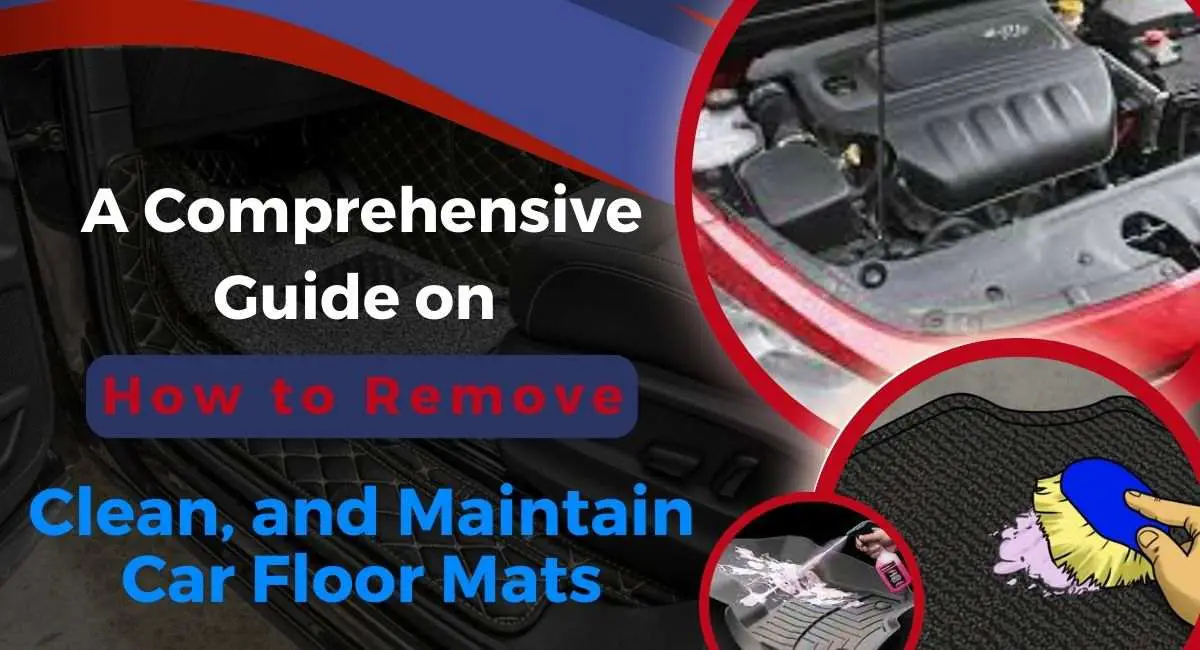Whether you navigate the bustling city streets in a sleek Honda sedan, traverse off-road terrains in a rugged Honda SUV, or command the highways with a robust Honda truck, one thing remains constant – your trusty car floor mats. These often overlooked mats silently bear the brunt of daily commutes, adventurous escapades, and even the occasional spilled coffee mishap.
From muddy footprints to slushy winter trails, your car floor mats are your vehicle’s interior, shielding from the elements and unexpected spills. As stalwart protectors, they deserve more than just a passing acknowledgment – they deserve a routine spa day!
In this guide, we’ll embark on a journey together to look at:
- the different types of car floor mats,
- how to remove car floor mats,
- understand the fasteners and
- explore a guide on cleaning and drying car floor mats to ensure they stay resilient.
So, let’s discover the secrets to keeping your car mats in top-notch condition, ready for whatever adventures!
What are the Different Types of Car Floor Mats?
Car floor mats come in various types and materials, catering to different needs, preferences, and vehicle models. Here are some common types of car floor mats based on material and manufacturing process:
Carpet Floor Mats are like cozy blankets for your car, made from soft fabric or carpet material. They come in many colors and have a unique bottom to keep them from sliding around. These mats make your car feel comfy and look nice inside.
Rubber Floor Mats are the tough protectors of your car. They are crafted from sturdy rubber or robust materials capable of withstanding various weather conditions. They’re great at trapping water, mud, and snow, keeping your car clean. And when it’s time to clean them, it’s super easy!
All-Weather Floor Mats are like superheroes for your car floor. They can handle any weather because of their make—from rubber, plastic, or other strong materials. They’re tough shields against water, mud, and dirt, ensuring your car stays safe and clean.
Clear Vinyl Floor Mats are the invisible protectors. They’re made from see-through vinyl, so you can still see your car’s original carpet. Perfect if you want to show off a unique interior or keep things sleek and clean.
Luxe Carpet Mats are the fancy mats for a touch of luxury. These carpets are high-quality, soft carpet that feels nice. These mats bring elegance to your car, often seen in high-end or fancy vehicles.
Each type of mat has its own story, from the comfy feel of the carpet to the tough protection of rubber and the luxury touch of plush carpet. They’re not just mats but like friends for your car, adding a personal touch to your driving journey. Besides, these are a few variant types of car floor mats you can check out.

How to Remove Car Floor Mats
Removing car floor mats may seem simple, but it’s crucial to do it correctly to avoid any mishaps that could compromise the protection they offer for your vehicle’s interior. Here are the steps on how to remove car floor mats. But first, let’s understand the fasteners.
Understand the Fastener Types
The term “carpet fasteners” typically refers to devices or mechanisms to secure carpets or floor mats within a vehicle. These fasteners are designed to prevent the carpets or mats from shifting or sliding around, ensuring they stay in their intended position and provide adequate coverage and protection for the vehicle’s floor.
So, you must identify the fastener type securing your floor mat. There are three common types: button clips, twist-locks, and hooks.
Button Clip Fasteners
- For mats with button clip fasteners, gently slide your hand under the mat nearest the button clip.
- Use two hands for better control – one underneath to hold the button clip down and the other to lift the mat.
- Listen for a popping sound, indicating the unfastening of the mat from the button clip.
- Lift the mat up and out of the vehicle.
Twist-Lock Fasteners
If your mats have twist-lock fasteners, rotate the lock before removing the mat.
Lift the mat up and out of the car, similar to the process with button clips.
Hook Fasteners
For mats with hook fasteners, use two hands – one to lift the floor mat and the other to move the mat closer to the seat, around, and off the hook fastener.
Once unhooked, lift the mat up and out of the vehicle.
Be Mindful of Vehicle Differences. Recognize that every vehicle may have different fastener types. Some may have clips, twist-locks, hooks, or none at all.
Regular Maintenance
It is wise to remove the mats regularly for cleaning. Despite your best efforts, floor mats can accumulate dirt over time.
Use Caution
Avoid simply pulling and yanking on the mats, as this could damage the fasteners or the mats.
Handle cautiously to maintain the mats’ effectiveness in safeguarding your vehicle’s interior.
Step-by-Step Guide on How to Remove, Clean, and Dry Car Floor Mats
Before diving into removing, cleaning, and drying your car floor mats, ensure you have gathered all the necessary tools as mentioned below:
Gathering Necessary Tools and Materials
Gathering all the necessary tools and materials before removing, cleaning, and maintaining your car floor mats is crucial. Here’s a list of what you’ll need:
- Vacuum cleaner
- A brush or soft-bristle brush
- Mild detergent or carpet cleaner
- A bucket of warm water
- A hose or access to clean water for rinsing
- A hose nozzle or high-pressure spray nozzle
- A sponge or cloth
- A towel or absorbent cloth
- A sunny, well-ventilated area for drying
While these are the essential tools and materials required for the job, you may also need specialized products depending on your specific car mat type. For example, rubber mats may require a different cleaning solution than carpeted ones.
Safety should be your top priority when working on your car mats. Ensure you have a safe workspace, and consider wearing gloves to protect your hands from dirt and cleaning chemicals.
Now that you have everything you need let’s dive into the step-by-step process of removing, cleaning, and drying your car floor mats:
Step 1: Prepare the Car
Before you start working on your car mats, it’s essential to prepare the car:
- Park your car in a safe and well-lit location.
- Switch off the engine and take the keys out of the ignition.
- These precautions ensure your safety and prevent accidents while working on your vehicle.
Step 2: Open the Car Doors
Opening the car doors serves two purposes:
- It allows you to access the floor mats easily.
- It helps in providing adequate ventilation while cleaning and drying the mats.
Ensuring adequate ventilation is crucial to avoid mold and mildew in your car, particularly following the cleaning of your mats.
Step 3: Locate the Floor Mats
Before removing your car floor mats, locate them within your vehicle. In most cars, you’ll find the floor mats on both the driver and passenger sides, in the front and rear of the vehicle. Floor mats are on the vehicle’s floor, directly beneath the seats.
Step 4: How to Unclip the Car Mats
As mentioned, securing car mats in place is done with clips or fasteners. The attachment method can vary depending on your car’s make and model. To unclip the car mats, follow these general guidelines, but check specific guidelines for different fasteners in the section above. So,
- Lift the front edge of the floor mat.
- Locate the fasteners or clips underneath.
- Gently release the clips by sliding them out or unhooking them.
- Slowly pull the mat upwards, removing it from under the seats.
It’s crucial to unclip car mats carefully to avoid damaging the clips or the mats themselves. If you need help with how the mats are attached, consult your car’s manual for guidance.
Step 5: Remove the Car Mats
With the mats unclipped, you can now remove them from the car. Here’s how to do it properly:
- Lift the floor mats out of the car one by one.
- Be cautious not to drag them against the vehicle’s interior, which can transfer dirt and debris back onto the floor.
- Once removed, place the mats in a clean, dry area or a workspace designated for cleaning.
- By following these steps, you’ll ensure the removal of your mats without causing any damage to your car’s interior.
Step 6: Clean and Dry the Mats
Cleaning your car mats is a critical part of the process. Regular cleaning helps maintain the mats’ appearance and extends their lifespan.
Here’s how to clean and dry car mats effectively:
Cleaning Car Mats
There are various methods to clean your car interiors and mats. You can either vacuum or spot-clean. Below is a clear explanation of how to go about it.
Vacuuming
- Start by vacuuming the mats to remove loose dirt and debris. Utilize a brush-attached vacuum cleaner to reach into nooks and corners.
- Pay extra attention to areas that accumulate more dirt, like the driver’s side.
Spot Cleaning
- Inspect the mats for any stubborn stains or spots.
- Mix a mild detergent or carpet cleaner with warm water in a bucket.
- Dip a brush or sponge into the soapy water and gently scrub the stained areas.
- Thoroughly wash the mats with fresh water to eliminate any lingering soap residue.
Drying Car Mats
Air-Drying
Hang the mats over a clothesline or a sturdy rod in a well-ventilated area.
Ensure the mats are not in direct sunlight, as extended exposure to the sun may result in fading.
Allow the mats to air-dry completely before placing them back in the car.
Use of a Dryer or Sunlight
In case of urgency, you can use a dryer on a low setting to hasten the drying process.
Alternatively, you can lay the mats out in a sunny area for faster drying.
It’s essential to ensure the mats are completely dry before reinstalling them in your car. Damp mats can lead to a musty odor in your vehicle and even promote mold growth.
Step 7: Inspect and Maintain the Mats
After cleaning and drying your car mats, examining them for any indications of damage or wear is a good practice. Regular maintenance is critical to keeping your mats in top condition.
Check for any loose threads, tears, or damage to the mats. If you identify any problems, consider fixing or replacing them as needed.
Reattach any clips or fasteners securely before returning the mats to your car.
For carpeted mats, periodically brush or vacuum them to avoid the buildup of debris and dirt.
Conclusion
Maintaining clean and well-maintained car floor mats is essential to preserving your vehicle’s interior and ensuring a pleasant driving experience. Following the step-by-step guide in this article on removing car floor mats, unclipping them, and drying them effectively, you can keep your mats in excellent condition.
Important Read: Why Does BMW Not Recommend Rotating Tires?
Routine cleaning and maintenance prolong the lifespan of your mats and contribute to a healthier and more comfortable environment inside your car. So, take the time to care for your car mats, and your vehicle will thank you with a clean and fresh interior.
